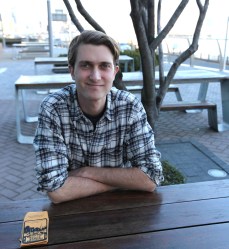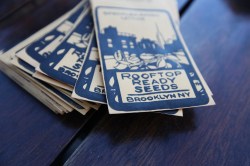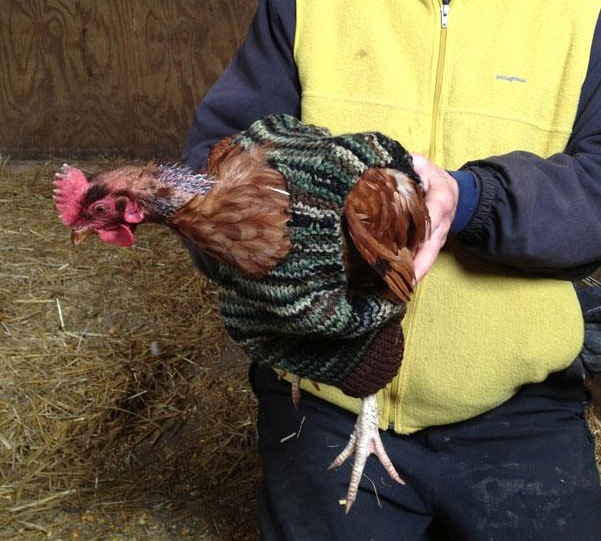
Chrissa YeeZach Pickens.
When Zach Pickens first started gardening on his New York rooftop six years ago, he learned the hard way that growing plants in an urban environment isn’t the same as tending them in a suburban backyard. “The first year was really terrible,” he says. But he welcomed the challenge, and his struggles prompted him to learn more about the science of gardening — microclimates, ecosystems, seed development.
Seed saving — the practice of collecting the seeds of naturally reproducing plants to be used again from year to year — particularly intrigued him. “I got interested first and foremost because it was saving me money. I’d save my own seed and didn’t have to buy [more] next year,” Pickens says. As he immersed himself in New York’s urban-gardening culture, he started to see seed saving’s potential to help the movement thrive, and wanted to spread the word.
Pickens noticed that if he saved the seed of the season’s healthiest plants, next year’s crop would be even better — he was essentially selecting for whatever traits helped his veggies grow best in containers on the roof. Before Monsanto and other corporate giants began pushing patented seeds that didn’t reproduce, forcing farmers to buy new seed every year, seed saving was a common practice that not only saved growers money but produced hardier plants, as the varieties selected year after year adapted to local conditions. By saving seed, Pickens can home in on plants that thrive in the hyper-local conditions unique to the big city.
Okra, for example, takes advantage of the urban heat island effect, in which all that concrete and asphalt absorbs the day’s heat, making New York City toastier than nearby rural communities. “In the city we can grow okra pretty well because it stays so warm through the night,” Pickens explains. “The okra loves it.” Plus, the dwarf variety Pickens favors only grows about three feet tall, perfect for containers.
Bloomsdale spinach, a curly-leaf variety, works well for the opposite reason — it can withstand cold and survive the winter. This spinach didn’t thrive at first: “It took about two or three generations from the seed I started with to get it to produce well,” Pickens says. “That’s my example of something that really struggled for the first generation.”

Chrissa Yee
Pickens, who holds a day job as farm manager for Manhattan’s Riverpark Farm, started Rooftop Ready Seeds in 2010, selling his specialized seeds less out of financial motivation and more out of concern for the greater urban-gardening good. He’s a “big supporter of getting as many people gardening and farming in the city as possible,” Pickens says. “If people buy my seeds and they have more success in their garden than otherwise, that’s good for everybody.”
He started with five seed varieties on offer at a Williamsburg garden store. The first 50 packs he brought in sold out within a week, and the store owner — with whom Pickens split the revenue 50-50 — called asking if he had more. “That was really my sign to ramp it up,” he said. The next year, he had access to two rooftop gardens in addition to his own — ones he maintained in return for the ability to save seed there. This year, Pickens is selling 25 seed varieties from the Brooklyn Grange farm stand and online. In exchange for helping with the grange’s own seed-saving efforts, he gets to select some of its seeds for his stock.
Saving seed is an ancient but tricky art. Once you’ve chosen the plant whose seed you want to save, you have to isolate it from others to avoid cross-pollination. Letting a plant go to seed also means you won’t get to harvest it at its prime — though Pickens says he tries to be resourceful by making sauces and spreads from some gone-to-seed plants (like tomatoes). Then there’s the often-painstaking process of drying the seed, opening it (“flailing”), and separating the chaff (“threshing”). Pickens does all this in winter, when the pace at Riverpark Farm is slower.
Given its decidedly scrappy ethos, is Rooftop Ready a reference to the name of Monsanto’s infamous Roundup Ready seeds? “What I’m worried about is a lawyer asking me that question,” Pickens laughs. “I absolutely didn’t plan on it being a play on Roundup Ready. But if you really want to get into it, yeah, it is in direct opposition to [Monsanto’s] way of producing seed.”
Monsanto’s practice of patenting its seeds — and going after farmers who violate those patents, sometimes as a result of unintentional cross-pollination — is, indeed, a direct contradiction to the seed-saving mindset, which is all about preserving heritage varieties and freeing growers from the control of big agribusiness.
“[Rooftop Ready] may be a business, but that seed is open-pollinated,” Pickens says. “If you wanted to, you could buy all [my varieties], grow them out, and save the seeds.” In other words, he’s not interested in making gardeners rely on his seeds like conventional farmers do on Monsanto’s, but rather on increasing the self-sufficiency of all growers.
Which is more important than ever now, as climate change disrupts weather patterns and shifts growing zones. “That’s the argument for biodiversity; that’s the argument for not planting monocrops,” Pickens says. “You might find out that that’s the one crop that can’t stand up to particular conditions.”
Even as Rooftop Ready grows as a business, Pickens’ enthusiasm reveals the venture as a labor of love, one still rooted in his zeal for learning about the scientific processes that make plants grow and reproduce. He hopes to experiment more with cross-breeding to find the best varieties possible, cross-pollinating the plants with the most desirable traits.
The work, he says, is “like a scientist’s playground.”
Watch Pickens give a quick explanation of seed saving at Riverpark Farm:



